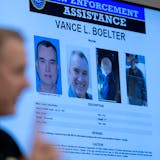A faux pas during a conflict in a Namibian park becomes a lesson in respecting a place and its customs. Adopting the local habit of gearing up for potential bear encounters in rural Alaska demonstrates why it's necessary to respect the area's people. A visit to a market in Singapore shows the importance of embracing uncertainty.
In "The World Has a Big Backyard," Mike Day, former executive vice president of the Science Museum of Minnesota, offers evocatively detailed accounts of experiences he had in exotic locations as executive producer of more than a dozen Imax films.
But "The World Has a Big Backyard" is more than a travel memoir. It's also an advice book that uses lessons Day learned while traveling to illustrate attitudes and habits that could be useful to any traveler anywhere — useful, in fact, in various situations throughout life.
Day recently spoke about how he got into that work, how he remembered all those details and what's next on his travel agenda. His answers have been edited for length.
Q: Could you talk about what initially brought you to the Science Museum and how you got into making Imax films?
A: Following my graduation from the University of Illinois, I took a position with the Rockford Park District to develop public programming with a science focus. My work there led to my being awarded a New York State Arts Council grant to study museum management. That was in Rochester, N.Y., world headquarters for Kodak, which gave me my first experience in film. From there I went to work at the Cleveland School of Science, working in new media formats including large-format film. That led to being recruited to the Science Museum of Minnesota in St. Paul to help launch a new museum building that included the William L. McKnight-3M Omnitheater, an Imax dome theater.
Q: When you realized the work would involve extensive exotic travel, were you excited or wary?
A: One of my favorite classes in high school was geography. I didn't just want to look at National Geographic magazines, I wanted to fall into the pages. I had done some traveling outside of the United States before moving to Minnesota, but making giant-screen films for the Science Museum led me to places I had no awareness of, places like the erupting Sakurajima volcano in Japan and uninhabited jungles in Central America.
Q: How and when did you decide to write a book about traveling?
A: When I would return from my filmmaking trips, like to the tallest sand dunes in the world in Namibia, or chasing tornadoes in Nebraska, people would hear my stories and say, "You should write a book." I didn't think much about that idea until I retired in early March 2020. The next week the pandemic was declared. I found myself with time, and being socially distant, I had the opportunity to do two things I wanted to do more of — reading and writing.
Q: The book is full of exquisitely detailed memories. Did you keep journals?
A: I took something from my office when I retired that held many memories — a big Tupperware tub of photos, letters, film production records and such. It was a treasure chest of artifacts that sparked vivid memories of my sojourns around the world.


